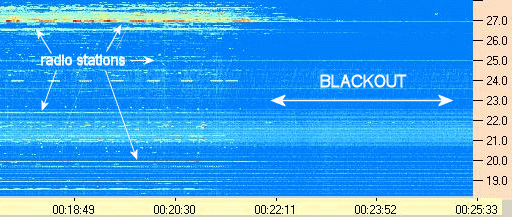Space Weather. com
by Dr. Tony Phillips.RADIO BLACKOUT:
An X-class
solar flare on April 25th irradiated Earth's upper atmosphere with
extreme ultraviolet radiation. Waves of ionization rippled around the
dayside of the planet, causing a widespread blackout of shortwave radio
transmissions. Radio astronomer Dick Flagg recorded the event at his
observatory at the Windward Community College on Oahu:
"This
is a dynamic spectrum," explains Flagg. "The vertical axis is frequency
(MHz) and the horizontal axis is time (UTC)." All of the horizontal
lines corresponding to terrestrial radio stations vanished in the
aftermath of the flare.
The active region responsible
for the flare rotated off the solar disk yesterday, so even if it
flares again, another radio blackout is unlikely this weekend. NOAA
forecasters estimate the odds of an X-flare on April 26th to be a scant
1%.
.....
Space .com
Sun Unleashes Major Solar Flare (Video)
By Tariq Malik, Managing Editor | April 25, 2014 06:47am ET
An X1.3-class solar flare (far right) erupts from the surface of the sun on April 24, 2014 EDT (April 25 GMT).Credit: NASA/Solar Dynamics Observatory

X-class flares top the scale with the most energy and potential to disrupt communications on Earth. See how solar flares compare to each other in this Space.com inforgraphic.
Credit: Karl Tate, SPACE.com Contributor
The
sun erupted with a massive solar flare late Thursday (April 24),
triggering a temporary communications blackout on some parts of Earth.
The
powerful flare peaked at 8:27 p.m. EDT Thursday (0027 April 25 GMT),
and ranked as an X1.3-class solar storm, one of the strongest types of
flares the sun can experience, according to a report from the U.S. Space
Weather Prediction Center. NASA's sun-watching Solar Dynamics
Observatory captured video of the intense solar flare in several difference wavelengths.
The solar flare erupted from an active sunspot region known as Region 2035 located on the far western side (or limb) of the sun as seen from Earth. Because of its position, the flare sparked a high-frequency radio blackout for about an hour on the daytime side of Earth, most likely over the Pacific Ocean and Eastern Pacific Rim, according to the SWPC update. [Photos: The Biggest Solar Flares of 2014]
Read More and Watch Video Here
The solar flare erupted from an active sunspot region known as Region 2035 located on the far western side (or limb) of the sun as seen from Earth. Because of its position, the flare sparked a high-frequency radio blackout for about an hour on the daytime side of Earth, most likely over the Pacific Ocean and Eastern Pacific Rim, according to the SWPC update. [Photos: The Biggest Solar Flares of 2014]
Read More and Watch Video Here






No comments:
Post a Comment
Hello and thank you for visiting my blog. Please share your thoughts and leave a comment :)